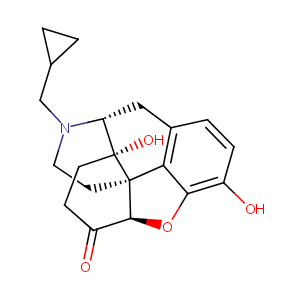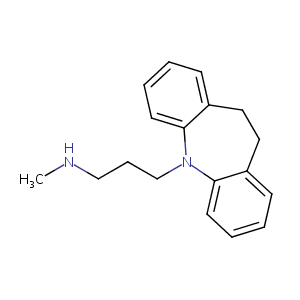| 1 |
ClinicalTrials.gov (NCT00338962) Naltrexone & SSRI in Alcoholics With Depression/PTSD
|
| 2 |
Drugs@FDA. U.S. Food and Drug Administration. U.S. Department of Health & Human Services. 2015
|
| 3 |
FDA Approved Drug Products from FDA Official Website. 2019. Application Number: (ANDA) 074918.
|
| 4 |
Naltrexone FDA Label
|
| 5 |
URL: http://www.guidetopharmacology.org Nucleic Acids Res. 2015 Oct 12. pii: gkv1037. The IUPHAR/BPS Guide to PHARMACOLOGY in 2016: towards curated quantitative interactions between 1300 protein targets and 6000 ligands. (Ligand id: 1639).
|
| 6 |
ClinicalTrials.gov (NCT04365985) Study of Immunomodulation Using Naltrexone and Ketamine for COVID-19. U.S. National Institutes of Health.
|
| 7 |
URL: http://www.guidetopharmacology.org Nucleic Acids Res. 2015 Oct 12. pii: gkv1037. The IUPHAR/BPS Guide to PHARMACOLOGY in 2016: towards curated quantitative interactions between 1300 protein targets and 6000 ligands. (Ligand id: 2399).
|
| 8 |
An evaluation of mu-opioid receptor (OPRM1) as a predictor of naltrexone response in the treatment of alcohol dependence: results from the Combined Pharmacotherapies and Behavioral Interventions for Alcohol Dependence (COMBINE) study. Arch Gen Psychiatry. 2008 Feb;65(2):135-44.
|
| 9 |
In vivo chronic exposure to heroin or naltrexone selectively inhibits liver microsome formation of estradiol-3-glucuronide in the rat. Biochem Pharmacol. 2008 Sep 1;76(5):672-9.
|
| 10 |
Low dose naltrexone therapy in multiple sclerosis. Med Hypotheses. 2005;64(4):721-4.
|
| 11 |
Chronic naltrexone treatment induces desensitization of the luteinizing hormone pulse generator for opioid blockade in hyperprolactinemic patients. J Clin Endocrinol Metab. 1995 May;80(5):1739-42. doi: 10.1210/jcem.80.5.7745028.
|
| 12 |
Association between the Stin2 VNTR polymorphism of the serotonin transporter gene and treatment outcome in alcohol-dependent patients. Alcohol Alcohol. 2008 Sep-Oct;43(5):516-22. doi: 10.1093/alcalc/agn048. Epub 2008 Jun 14.
|
| 13 |
Predicting the effect of naltrexone and acamprosate in alcohol-dependent patients using genetic indicators. Addict Biol. 2009 Jul;14(3):328-37.
|
| 14 |
Augmentation effect of combination therapy of aripiprazole and antidepressants on forced swimming test in mice. Psychopharmacology (Berl). 2009 Sep;206(1):97-107.
|
| 15 |
A novel screening strategy to identify ABCB1 substrates and inhibitors. Naunyn Schmiedebergs Arch Pharmacol. 2009 Jan;379(1):11-26.
|
| 16 |
Implications of genetic polymorphisms in drug transporters for pharmacotherapy. Cancer Lett. 2006 Mar 8;234(1):4-33.
|
| 17 |
Variability in metabolism of imipramine and desipramine using urinary excretion data. J Anal Toxicol. 2014 Jul-Aug;38(6):368-74.
|
| 18 |
Summary of information on human CYP enzymes: human P450 metabolism data. Drug Metab Rev. 2002 Feb-May;34(1-2):83-448.
|
| 19 |
Dose-dependent inhibition of CYP1A2, CYP2C19 and CYP2D6 by citalopram, fluoxetine, fluvoxamine and paroxetine. Eur J Clin Pharmacol. 1996;51(1):73-8.
|
| 20 |
Drugs that may have potential CYP2B6 interactions.
|
| 21 |
Eight inhibitory monoclonal antibodies define the role of individual P-450s in human liver microsomal diazepam, 7-ethoxycoumarin, and imipramine metabolism. Drug Metab Dispos. 1999 Jan;27(1):102-9.
|
| 22 |
Inhibition of cytochrome P450 enzymes participating in p-nitrophenol hydroxylation by drugs known as CYP2E1 inhibitors. Chem Biol Interact. 2004 Apr 15;147(3):331-40.
|
| 23 |
Development of a highly sensitive cytotoxicity assay system for CYP3A4-mediated metabolic activation. Drug Metab Dispos. 2011 Aug;39(8):1388-95. doi: 10.1124/dmd.110.037077. Epub 2011 May 3.
|
| 24 |
Anti-inflammatory properties of desipramine and fluoxetine. Respir Res. 2007 May 3;8(1):35. doi: 10.1186/1465-9921-8-35.
|
| 25 |
Coadministration of histone deacetylase inhibitors and perifosine synergistically induces apoptosis in human leukemia cells through Akt and ERK1/2 inactivation and the generation of ceramide and reactive oxygen species. Cancer Res. 2005 Mar 15;65(6):2422-32. doi: 10.1158/0008-5472.CAN-04-2440.
|
| 26 |
Desipramine-induced Ca-independent apoptosis in Mg63 human osteosarcoma cells: dependence on P38 mitogen-activated protein kinase-regulated activation of caspase 3. Clin Exp Pharmacol Physiol. 2009 Mar;36(3):297-303. doi: 10.1111/j.1440-1681.2008.05065.x. Epub 2008 Oct 15.
|
| 27 |
Block of the human ether-a-go-go-related gene (hERG) K+ channel by the antidepressant desipramine. Biochem Biophys Res Commun. 2010 Apr 9;394(3):536-41. doi: 10.1016/j.bbrc.2010.03.010. Epub 2010 Mar 6.
|
|
|
|
|
|
|


